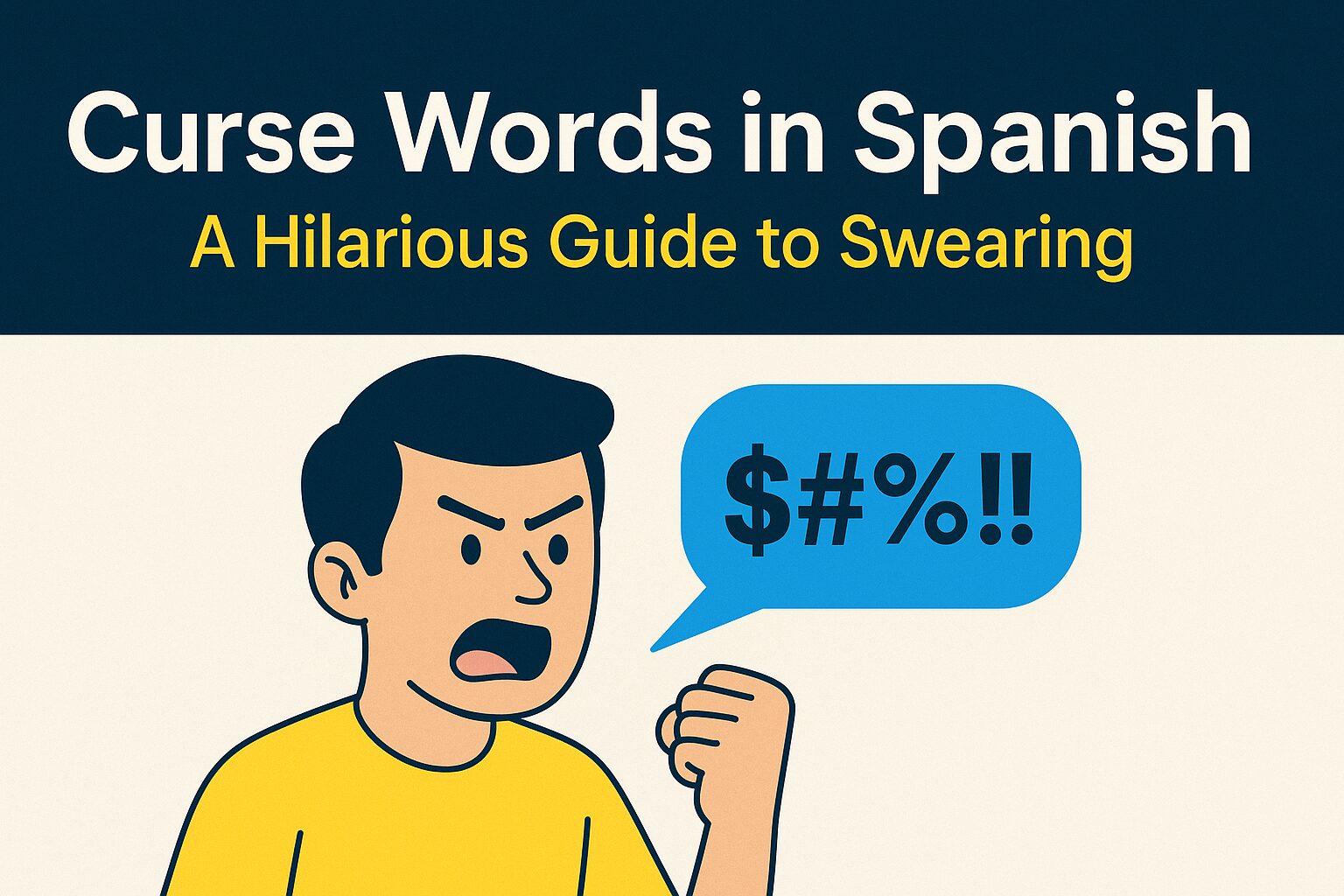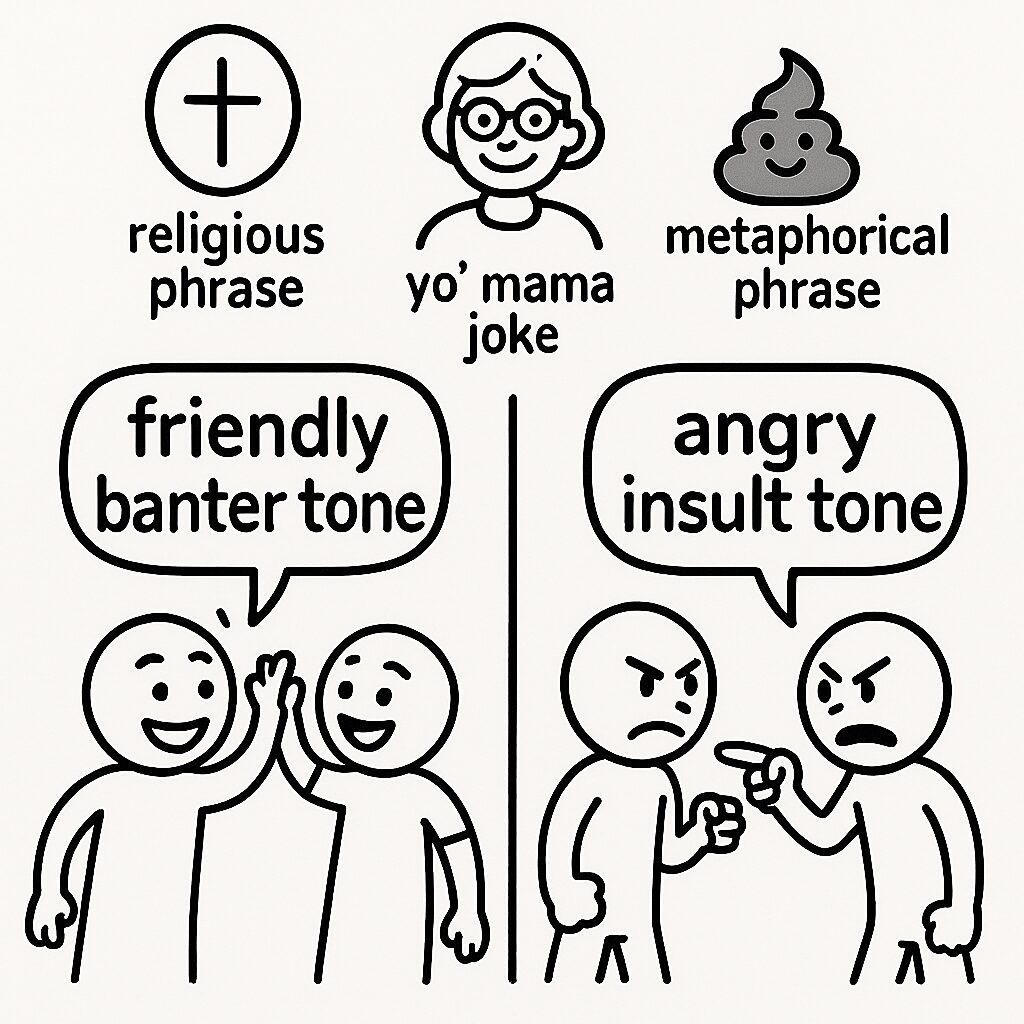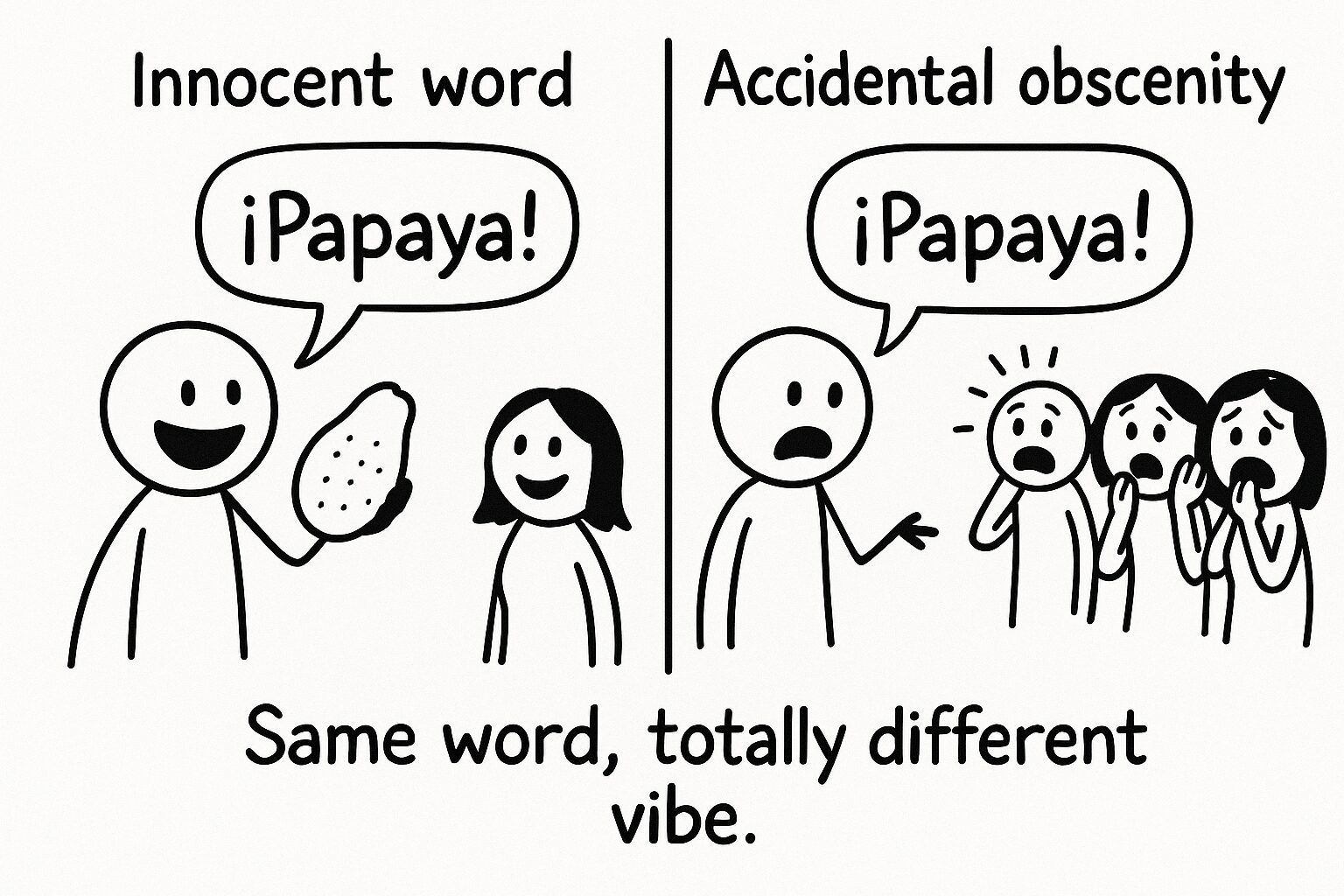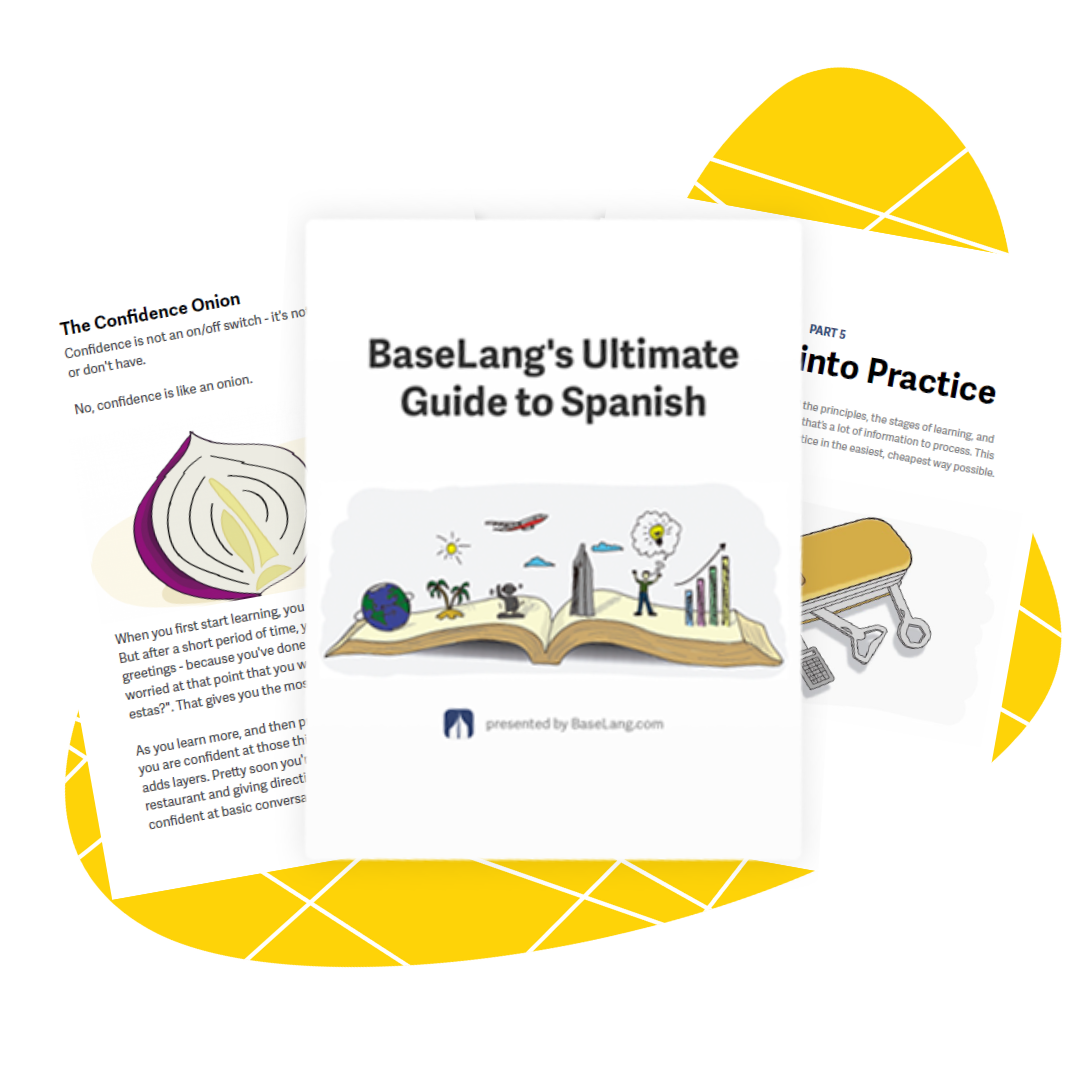50 Spanish Curse Words: A Hilarious Guide to Swearing

Get our free email course, Shortcut to Conversational.
Have conversations faster, understand people when they speak fast, and other tested tips to learn faster.
More infoOf course you want to learn curse words in Spanish! It’s a rite of passage for language learners and something we are curious about. A quick Google search for bad words in Spanish or Spanish bad words will spit out plenty of lists. But most of those just give you translations without the stories, the cultural nuance, or the warning labels. Before you charge into a bar in Barcelona or Mexico City dropping F-bombs in Spanish, let’s make sure you know what you’re doing (and who you might be insulting!).
Heads up! This post includes explicit language and cultural references that may offend some readers. While we don’t encourage swearing, these expressions are widely used across Spain and Latin America, and understanding them is key to navigating real-world Spanish.
Now that we have that parental advisory message over with, let’s learn how to curse in Spanish.
TL;DR — The most common Spanish curse words
The swear words you’ll hear most often in Spanish are:
mierda (“sh*t”),
joder (“f*ck/damn,” common in Spain),
carajo (“hell/damn”),
cabrón (“a**hole/b*stard”),
pendejo (a harsh “idiot” in Mexico),
and coño (very strong in Spain, but a casual interjection in some Caribbean countries).
How offensive they sound depends a lot on where you are: in Spain, joder and coño are used casually among friends;in Mexico, pendejo and anything with chingar are considered much stronger; and in Argentina, boludo can swing from friendly (“hey, buddy”) to insulting depending on tone.
The art of swearing in Spanish: tone and cultural context
As Spanish isn’t just spoken in Spain, each country has its own swearing style.
Across the board, one thing is true: “Spanish speakers love their swear words.” Swearing is like a cultural sport, where a well-timed ¡Hijo de puta! or ¡La hostia! can convey pain, joy, anger, or camaraderie depending on how you say it.
Tone is everything. In Spanish, you can call your best friend cabrón (literally “big goat,” used like “bastard” or “dude”) with a grin, and it’s a sign of affection.
Say ¡Qué cabrón eres! (“What a bastard you are!”) while laughing, and your friend might just laugh with pride. But growl cabrón with a deadly glare, and you’ve made an enemy. The same word flips from friendly to fighting based on context and tone.
Religion and family are particularly spicy ingredients in Spanish swear words.
In Spain, phrases like la hostia (literally “the [sacramental] host”) can be a casual “damn” or “awesome” among friends, but can offend the religious if used carelessly.
And nothing unites Spanish-speaking cultures more than the universal love of yo’ mama insults. A casual ¡Tu madre! can be an innocent joke or a grave insult. (Pro tip: Unless you’re very sure it’s friendly banter, maybe don’t involve anyone’s mother!)
Also, keep in mind that literal meanings often get lost. If someone shouts ¡Me cago en diez! (“I shit on ten!”) they’re probably just really upset, not making a bizarre bathroom plan.
Spanish profanity is full of metaphors that no one takes literally anymore. That’s why cojones just means “balls” as in courage (“He’s got cojones!”), even though it literally means, well, actual balls!
One language, many profanity dialects: regional differences
Spanish is spoken in so many places that a swear word in one country can be totally harmless in another, or vice versa. This is where naive Spanish learners hilariously get in trouble. Let’s visit a classic example:
Same phrase, different outcome
In Spain, coger simply means “to take” (like coger el autobús = “to take the bus”).
But in Argentina, coger bluntly means “to f**k” – not something you announce to strangers! So, a happy traveler might say “Voy a coger el bus” in Madrid and everyone’s fine. But if he says the same in Buenos Aires, the locals are doing a double-take or giggling. You’ve been warned!
And it’s not just Argentina. In much of Latin America, coger = to screw (in the sexual sense). The poor Spanish word didn’t deserve this fate, but history and slang took over.
If you learned “coger” = “to take” in a textbook and then go to Mexico saying “¿Dónde puedo coger un taxi?”… Well, you might get some raised eyebrows or smirks.
⚠️ Use tomar or agarrar for “take” instead, just to be safe.
This kind of regional misfire doesn’t stop at coger. Another famous word is: concha.
In Spain, concha means “seashell” and is also a common woman’s nickname. In Argentina, la concha is very crude slang for the female anatomy. 😳 So don’t go proudly showing off your shell collection, saying “Mira mi concha bonita” in Buenos Aires. People will wonder why on earth you’re talking about your vagina. (Yes, really.)
Other examples: In Puerto Rico, bicho literally “bug” is slang for “penis.” In much of the Caribbean, papaya is a fruit… except in Cuba, where papaya is a vulgar word for the same lady-part that concha refers to. Cuban folks actually call the fruit fruta bomba (bomb fruit) to avoid saying papaya!
Innocent word or accidental obscenity
Every Spanish-speaking country has its own repertoire of insults and cusses.
Mexican Spanish is famous for chingar and its endless variations, while Spain loves its religious expletives (hostia, me cago en Dios, etc.).
Argentina will call you boludo or pelotudo (both roughly “idiot/doofus,” but often endearingly among friends).
Chile has weón (huevón), which can mean anything from “buddy” to “idiot” depending on context.
The list goes on.
Remember: curse words are like regional cuisine: what’s served hot in one place might be completely off the menu elsewhere.
One more regional tip: even the word “swear word” varies.
In Spain, you might ask for tacos (yes, like the food) to mean swear words.
In Mexico, they say groserías or malas palabras; in Argentina, insultos or just puteadas; and so on.
If you blank on the term, just ask someone to teach you “las malas palabras.” Most natives will be more than happy to share their local bad words and the colorful stories behind them.
50 Spanish Curse Words: Use them at your own risk!
Here are some of the most widely known curse words in Spanish, and where you are more likely to hear them.
Universal bad words
(recognized almost everywhere in the Spanish-speaking world)
- Mierda — “shit” (everywhere)
- Carajo — “damn / fuck” (Spain & Latin America)
- Puta — “whore” (universal)
- Hijo de puta — “son of a bitch” (universal)
- Cabrón — “bastard / dude” (Spain, Mexico, C. America)
- Imbécil — “idiot” (universal)
- Tarado — “moron” (universal)
- Cojones — “balls / nerve” (Spain & Latin America)
- Mamón — “sucker / prick” (Spain & Latin America)
- Zorra — “slut / bitch” (Spain & Latin America)
Spain-only classics
- Coño — “fuck / damn”
- Hostia — “holy shit”
- Gilipollas — “jerk / asshole”
- Capullo — “asshole / idiot”
- Joder — “fuck”
- Tonto del culo — “dumb-ass”
- Me cago en… — “I shit on…” (frustration formula)
- La puta madre — “motherfucker / god-dammit”
- Que te den — “up yours”
- Polla — “cock”
Of course, Spanish slang goes way beyond curse words, so if you want to sound like a local in Madrid or Barcelona, check out our full guide to Spanish slang from Spain
Mexico and Central America
- Pendejo — “asshole / dummy” (Mexico)
- Pinche — “fucking” (intensifier) (Mexico)
- Chingar — “to fuck” (Mexico)
- Chingados — “what the fuck?!” (Mexico)
- Huevos — “balls” (Mexico & LatAm)
- Me vale madre — “I don’t give a damn” (Mexico)
- Joto — “sissy / gay slur” (Mexico)
- Puto — “male whore / slur” (Mexico & C. America)
- Chingadera — “fucking thing / crap” (Mexico)
- Culero — “asshole / jerk” (Mexico & C. America)
The Caribbean flair
- Papaya — “vagina” (Cuba)
- Pinga — “dick” (Cuba)
- Bicho — “dick” (Puerto Rico, Venezuela)
- Mamahuevo / Mamagüevo — “cocksucker” (D.R., Venezuela, P.R.)
- Puñeta — “fuck / damn” (Puerto Rico)
Caribbean Spanish is full of colorful slang that you won’t hear anywhere else. Puerto Rico is a perfect example—check out our guide to Puerto Rican slang to see how locals really talk.
Southern cone and Andes
(Argentina, Uruguay, Chile, Peru, Bolivia)
- Concha — “cunt” (Argentina, Uruguay)
- Boludo — “idiot / bro” (Argentina)
- Pelotudo — “moron” (Argentina)
- Forro — “asshole” (Argentina)
- Chupapijas — “cocksucker” (Argentina, Spain)
- Tragaleche — “cum-swallower” (Argentina)
- Bolacear — “to bullshit” (Argentina)
- Huevón / Weón — “dude / idiot” (Chile, Peru)
- Cojudo — “dumbass” (Peru, Bolivia)
- Cagón — “coward / piece of shit” (River Plate region)
And if you’re curious about all the unique ways people from Argentina bend Spanish, we’ve got you covered with our full list of Argentinian slang.
Colombia and neighbors
- Gonorrea — “jerk / asshole” (Colombia)
- Hijueputa — “son of a bitch” (Colombia)
- Culicagado — “brat / little punk” (Colombia)
- Pirobo — “loser / jerk” (Colombia)
- Marica — “pussy / dude” (Colombia, Venezuela)
Now you have 50 of the most colourful palabras sucias in neat regional bundles. Perfect for study, shock, or strategic deployment (use wisely!).
Final Thoughts
Spanish curse words are fun because they sound natural and express strong feelings. But they shouldn’t be used carelessly. Learning how each one sounds and means in different countries helps you understand local humor, friendship, and frustration. Use this knowledge to connect with people, not to shock or offend them unintentionally!
Practice these words by noticing how native speakers use them in conversation. Save them for moments that need extra spice or a good laugh. Be mindful of your facial expression and tone. Treat these words with respect, and you’ll see why many learners find Spanish a satisfying way to release stress.






